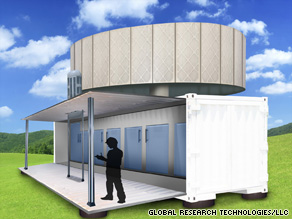Scientists in the United States are developing a "synthetic tree" capable of collecting carbon around 1,000 times faster than the real thing.
 As the wind blows though plastic "leaves," the carbon is trapped in a chamber, compressed and stored as liquid carbon dioxide.
As the wind blows though plastic "leaves," the carbon is trapped in a chamber, compressed and stored as liquid carbon dioxide.The technology is similar to that used to capture carbon from flue stacks at coal-fired power plants, but the difference is that the "synthetic tree" can catch carbon anytime, anywhere.
"Half of your emissions come from small, distributed sources where collection at the site is either impossible or impractical," said Professor Klaus Lackner, Ewing-Worzel Professor of Geophysics in the Department of Earth and Environmental Engineering at Columbia University.
"We aim for applications like gasoline in cars or jet fuel in airplanes. We are going after CO2 that otherwise is nearly impossible to collect," he told CNN.
While the idea of carbon-catchers may sound far-fetched, an early model has been built and Lackner is in the process of writing a proposal for consideration by the U.S. Department of Energy.
He personally explained the concept in a 45-minute meeting with U.S. Energy Secretary Steven Chu last month at a three-day symposium on climate change in London.
"He was there and I was there and he showed interest," Lackner told CNN. "That's exciting, but I don't particularly want to discuss this in a public forum because I think this gives me a little bit of an opportunity to tailor my proposals to the Department of Energy in a way that makes them more palatable."
Lackner started working on the concept of an ambient carbon catcher in 1998. "I argued back then and I still argue that the reason this can be done, from a theoretical point of view, is that the CO2 in the air is actually surprisingly concentrated, therefore the device you need to collect CO2 is quite small."
The "synthetic tree" looks more like a public convenience block than a hi-tech method of reducing carbon emissions, but Lackner told CNN it is highly efficient for its size when compared, for example, to a modern power-generating wind turbine.
"If you give me one of those big windmills which have those big areas through which the rotor moves -- how much CO2 can I avoid? And if I had an equally sized CO2 collector -- how much CO2 can I collect? It turns out the collector is several hundred times better than the windmill."
http://www.cnn.com/2009/TECH/science/06/22/synthetic.tree.climate.change.ccs/index.html